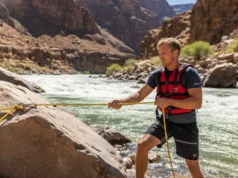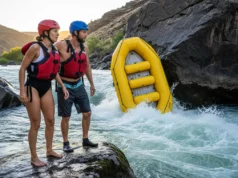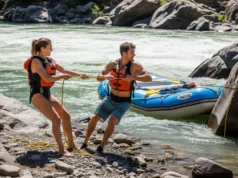In this article
The roar of the river is deafening as the raft, pinned hard against a mid-stream boulder, groans under thousands of pounds of hydraulic pressure. Your crew looks to you, and the rope in your hands will determine the next sixty seconds. Will it efficiently transfer your team’s power to free the boat, or will it wastefully stretch, turning a rescue into a failure? This guide is built for that moment. It transforms the complex world of rope rescue equipment from technical jargon into wilderness instinct, ensuring you not only know the difference between static vs dynamic ropes but can confidently deploy the right rope when it matters most.
We’ll start with the fundamental physics of force and why a rope’s stretch is its single most important characteristic. We’ll dissect the anatomy of a rope to understand how its materials perform, especially when soaked in wet conditions. From there, we’ll decode the safety standards that guarantee a rope is built for complex rescue operations. Finally, we’ll put it all together in the Z-Drag, the masterclass of rope rescue systems where a static rope is the non-negotiable heart of a successful recovery. You’ll move beyond the misconception that “a rope is a rope” and emerge with the confident, practical knowledge of a seasoned river guide.
Why Does Rope Stretch Matter on the River?
This section establishes the core scientific principles that differentiate static and dynamic ropes, linking the concept of elongation directly to the opposing needs of fall absorption versus hauling efficiency in dynamic rescue environments.
What is the critical difference between a dynamic and a static rope?
The primary distinguishing characteristic is elongation, or its stretch percentage under load. This single property dictates their entirely different and mutually exclusive use cases. Dynamic ropes are engineered as shock absorbers. They are designed for energy absorption, stretching significantly—up to 40% of their length—during a dynamic loading event, like a climber’s lead fall during rock climbing. This high elasticity is critical because, according to the impulse-momentum theorem, it increases the time over which the falling climber decelerates. This shock load reduction drastically lowers the peak force on their body, anchors, and gear. It’s the same principle behind kinetic recovery ropes used in off-road recovery to smoothly pull stuck vehicles without a damaging, sudden impact.
In contrast, static ropes (also known as semi-static or low stretch ropes) are designed for minimal stretch, typically less than 5%. Their rigidity is essential for situations where static loads are constant and predictable, such as for hauling, rigging complex systems, or ensuring a bounce-free, controlled descent while rappelling (abseiling). This difference isn’t a minor detail; it’s a fundamental choice in rope manufacturing. The internal fibers of a dynamic rope are twisted to act like a spring, while a static rope’s fibers run parallel. Using the wrong rope is dangerous. A dynamic rope in a haul system wastes all your pulling force in the stretch. Conversely, using a static rope to catch a significant fall can generate catastrophic impact force and cause severe injury or equipment failure, a critical consideration for both rafting setups and mountain rescues.
What Are You Actually Pulling On?
This section moves from the “what” to the “how,” explaining the material science and engineering methods that give static and dynamic ropes their distinct properties, with a special focus on performance in wet river environments.
How does a rope’s material affect its strength and performance in water?
Modern ropes use a kernmantle construction, consisting of a load-bearing inner core (the “kern”) and a protective outer sheath (the “mantle”). The core provides 75-90% of the rope’s tensile strength, while the sheath provides crucial durability and abrasion resistance. Key attributes like diameter, weight, and material define the rope’s application. The primary material for dynamic climbing ropes is Nylon (Polyamide), prized for its elasticity. For high-quality static ropes used in whitewater rescue, the premier material is Polyester (PES). Its low stretch and hydrophobic nature ensure excellent wet-strength retention. A third material, Polypropylene (PP), is used for floating ropes like throw bags where visibility on the water is key.
The critical weakness of Nylon for river use is that it is hydrophilic—it readily absorbs water, temporarily weakening the rope by as much as 30%. Polyester’s hydrophobic nature means it maintains its performance when wet, making it the superior choice. To combat this, manufacturers apply “dry treatments” to nylon ropes. The gold standard is the UIAA “Water Repellent” certification, ensuring a rope absorbs less than 5% of its weight in water. For dedicated haul lines, polyester is the ideal choice. This focus on material science is a core part of safe boating practices and is just as important as understanding your raft’s fabric.
Pro-Tip: Proper rope care is non-negotiable. After any river use, especially in silty water, always rinse your rope in clean, fresh water and let it air dry completely out of direct sunlight. Silt and sand particles work their way into the sheath and act like internal sandpaper, grinding away at the core fibers every time the rope bends and flexes. A clean rope is a stronger, safer, and longer-lasting rope.
How Do You Verify a Rope’s Safety and Purpose?
This section demystifies the technical codes and certifications found on rescue ropes, empowering the reader to make informed purchasing decisions based on internationally recognized performance benchmarks for real rescue demands.
What do the EN 1891 and NFPA 2500 ratings mean for a rafter?
The codes on a rope’s end-tag are guarantees of performance. While specialized ropes exist for fire rescue operations or arborist work, the core principles of strength and elongation are universal. For rafters, EN 1891 (Low Stretch Kernmantle Ropes) is a critical international standard. It mandates a static elongation of less than 5%, ensuring efficiency for hauling and ascending. Within EN 1891, Type A ropes are higher-grade with a minimum breaking strength (22 kN), ideal for heavy-load rescues. Type B ropes are lighter with a lower strength (18 kN).
In the US, professional rescue teams adhere to NFPA 2500, the “gold standard” for life safety rope rescue gear. This standard classifies ropes by intended use. “General Use” (G-Rated) ropes are for the highest loads, with an MBS of approximately 40 kN (9,000 lbf). “Technical Use” (T-Rated) ropes are for lighter loads. For a private rafter, an EN 1891 Type A static rope provides excellent static system safety. For professionals, an NFPA 2500 G-Rated rope is the appropriate choice. You can validate these UIAA standards and others directly from the source for NFPA standards for emergency services. Understanding these certifications is a key part of mastering rafting safety.
Static Rope Standards for Rescue
A comparison of EN and NFPA certifications for rescue ropes.
Primary Use Case
General / Heavy-Duty Rescue. Commonly used by private rafters and for general-purpose rescue systems.
Technical Specs
Minimum Breaking Strength of 22 kN (~4,950 lbf) with a maximum static elongation of less than 5%.
Primary Use Case
Lightweight / Personal Rescue. Designed for applications where rope weight is a primary concern, such as personal escape systems.
Technical Specs
Minimum Breaking Strength of 18 kN (~4,050 lbf) with a maximum static elongation of less than 5%.
Primary Use Case
Professional / Heavy Technical Rescue. This standard is for the most demanding rescue scenarios requiring high strength and durability.
Technical Specs
Minimum Breaking Strength of 40 kN (~9,000 lbf). Elongation must be less than 10% at a 1.35kN load.
Primary Use Case
Professional / “Light-is-Right” Scenarios. For skilled professionals in situations where lighter gear is a significant advantage, like backcountry or swiftwater rescue.
Technical Specs
Minimum Breaking Strength of 20 kN (~4,500 lbf). Elongation must be less than 10% at a 1.35kN load.
How Do You Apply This Knowledge in a Whitewater Rescue?
This final section provides a practical application of the article’s core principles, focusing on the construction and safe operation of a Z-drag system—a quintessential force-multiplying system for rope rescue.
Why is a static rope non-negotiable for a Z-Drag system?
The Z-drag is the most fundamental mechanical advantage system in whitewater rescue, a classic force multiplier in rescue rigging. The entire rope system’s effectiveness is predicated on the use of a static rope. Its low stretch nature ensures that nearly all the force generated by the pull is transferred directly into moving the load. If a dynamic rope were used, a significant portion of the effort would be wasted simply stretching the rope. This creates a “spongy” feel, making the haul exhausting and inefficient.
The core components of a Z-drag kit are one long static rope, webbing for an anchor, two high-efficiency pulleys, two prusik loops, and locking carabiners. One of the most critical safety components is the “progress capture” prusik. This friction hitch is a simple progress capture device; professional teams might use a mechanical ascender or a specialized pulley like a Petzl Micro Traxion for this role, but the principle is identical. Safe operation requires all rescuers to stay clear of the direct line of pull; a tensioned Z-drag stores immense energy. Using pulleys instead of carabiners is also highly recommended. Mastering the Z-drag lets you harness the physics of mechanical advantage with a Z-Drag rescue system.
Pro-Tip: Designate one person on the haul team as the “line tender.” Their only job is to manage the slack in the haul line, ensuring it feeds cleanly into the system and doesn’t create a tangled mess behind the pullers. A smooth pull is a safe and efficient pull.
Conclusion
The choice between static and dynamic rope is not a matter of preference; it’s dictated by load dynamics. Static ropes are for controlled hauling, rigging, and lowering, while dynamic ropes are exclusively for energy absorption during a high-impact fall. For river rescue scenarios, polyester static ropes are superior due to their hydrophobic properties. Safety and performance are verified by standards like EN 1891 Type A for private boaters and NFPA 2500 G-Rated for professionals, which guarantee low stretch and high strength. Without this knowledge, the Z-drag, the most essential raft rescue setup, is rendered ineffective and dangerous.
The right rope is your most critical tool in a crisis. Continue building your wilderness instinct by exploring our complete library of River Rescue and Safety guides, and always prioritize conservation practices on the water.
Frequently Asked Questions
Can I use my old dynamic climbing rope for my Z-drag kit?
No, you should never use a dynamic climbing rope for a Z-drag or any hauling system. Its inherent elasticity will absorb the pulling force, making the static pull extremely inefficient and rendering the rescue operation ineffective.
What is the best rope material for a dedicated river rescue haul line?
Polyester is the superior material choice for a dedicated river rescue static line. It is hydrophobic, meaning it absorbs very little water and maintains its full strength and low stretch characteristics when wet.
Is it okay to use a static rope for top-rope climbing to save money?
This is strongly discouraged. While a top rope fall involves less slack than a lead fall, a static rope offers no shock absorption and will deliver a jarring impact. This lack of shock load reduction puts dangerous stress on the climber’s harness, the belayer, and the anchor systems, violating core dynamic safety principles.
Is it better to have one long static line or just tie several throw bags together for a haul?
A single, continuous static line is far superior and safer for building a hauling system or any rescue rigging. Tying shorter ropes together introduces multiple knots, which are significant weak points (reducing equipment strength by 20-40%) and create major snagging hazards as they are pulled through pulleys or over rock edges.
Risk Disclaimer: Whitewater rafting, kayaking, and all related river sports are inherently dangerous activities that can result in serious injury, drowning, or death. The information provided on Rafting Escapes is for educational and informational purposes only. While we strive for accuracy, the information, techniques, and safety advice presented on this website are not a substitute for professional guide services, hands-on swiftwater rescue training, or your own critical judgment. River conditions, including water levels, currents, and hazards like strainers or undercut rocks, change constantly and can differ dramatically from what is described on this site. Never attempt to navigate a river beyond your certified skill level and always wear appropriate safety gear, including a personal flotation device (PFD) and helmet. We strongly advise rafting with a licensed professional guide. By using this website, you agree that you are solely responsible for your own safety. Any reliance you place on our content is strictly at your own risk, and you assume all liability for your actions and decisions on the water. Rafting Escapes and its authors will not be held liable for any injury, damage, or loss sustained in connection with the use of the information herein.
Affiliate Disclosure: We are a participant in the Amazon Services LLC Associates Program, an affiliate advertising program designed to provide a means for us to earn advertising fees by advertising and linking to Amazon.com. As an Amazon Associate, we earn from qualifying purchases. We also participate in other affiliate programs and may receive a commission on products purchased through our links, at no extra cost to you. Additional terms are found in the terms of service.





